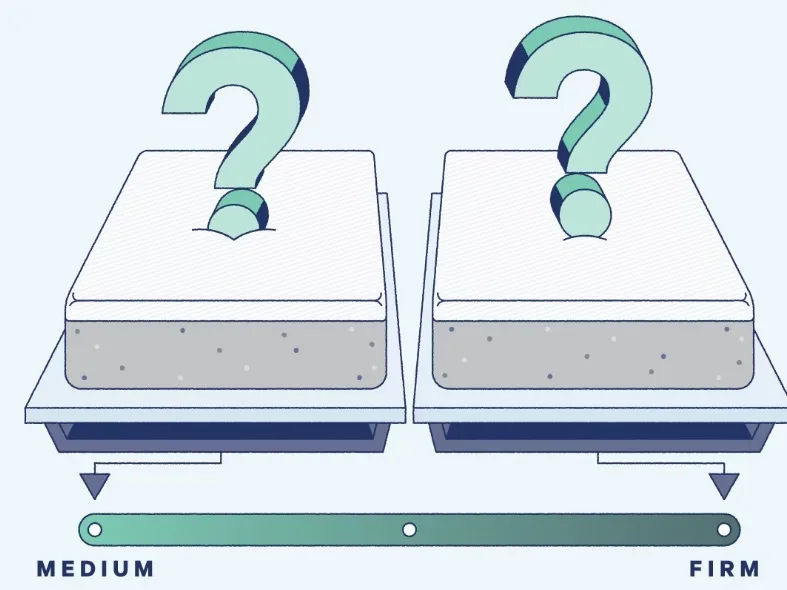Table of Contents Show
Choosing the right mattress is crucial for achieving a comfortable and restful night’s sleep. When it comes to selecting between firm vs. medium mattresses, understanding the pros and cons of each type can help you make an informed decision that best suits your sleep needs and personal preferences.

Understanding Mattress Firmness Levels
Mattress firmness is often rated on a scale from 1 to 10, with 1 being the softest and 10 being the firmest. Firm mattresses typically fall within the 7-9 range, while medium mattresses are usually rated around 4-6. This rating system helps consumers gauge how supportive or yielding a mattress will feel.
Pros and Cons of Firm Mattresses
Pros:
- Spinal Alignment: Firm mattresses provide a higher level of support, which can be beneficial for maintaining proper spinal alignment. This is particularly important for individuals with back pain or those who sleep on their back or stomach.
- Durability: Due to their dense construction, firm mattresses tend to last longer and resist sagging over time.
- Reduced Pressure Points: Firm mattresses can help distribute body weight more evenly, reducing pressure on specific points such as the hips and shoulders.
Cons:
- Initial Discomfort: It may take some time for your body to adjust to a firm mattress, especially if you are used to sleeping on a softer surface.
- Not Ideal for Side Sleepers: Firm mattresses might not provide enough cushioning for side sleepers, potentially leading to discomfort in the shoulders and hips.
Pros and Cons of Medium Mattresses
Pros:
- Balanced Support and Comfort: Medium mattresses offer a good balance between support and comfort, making them suitable for a wide range of sleep positions, including side, back, and combination sleepers.
- Pressure Relief: These mattresses provide enough give to relieve pressure points while still offering adequate support to maintain spinal alignment.
- Adaptability: Medium mattresses tend to be more adaptable and can accommodate different body types and sleeping preferences.
Cons:
- Potential for Sagging: Medium mattresses, especially those made from lower-quality materials, may be prone to sagging over time.
- May Not Offer Enough Support for Some: For individuals who require a higher level of support, such as those with significant back issues, a medium mattress might not be firm enough.
Choosing the Right Mattress for You
When deciding between a firm vs. medium mattress, consider your sleep position, body weight, and any specific health concerns. Here are some guidelines to help you make the right choice:
- Back Sleepers: Both firm and medium mattresses can work well for back sleepers, but a firm mattress may provide better spinal support.
- Stomach Sleepers: A firm mattress is generally recommended to prevent the hips from sinking too deeply and causing lower back strain.
- Side Sleepers: A medium mattress is often better for side sleepers, as it offers more cushioning for the shoulders and hips.
- Combination Sleepers: If you change positions throughout the night, a medium mattress might be the best option as it provides a balance of support and comfort for various sleeping styles.
- Body Weight: Heavier individuals might benefit from the additional support of a firm mattress, while lighter individuals may find a medium mattress more comfortable.
Mattress Materials and Their Impact on Firmness
The materials used in a mattress can also affect its firmness and overall feel. Here are some common materials and their impact:
- Memory Foam: Memory foam mattresses can range from soft to firm, but they tend to provide excellent pressure relief and contouring. A medium memory foam mattress is often ideal for combination sleepers.
- Latex: Latex mattresses are known for their durability and responsiveness. They can be found in various firmness levels, but a firm latex mattress is particularly beneficial for back and stomach sleepers.
- Innerspring: Innerspring mattresses usually offer firmer support due to their coil-based construction. However, the addition of a plush top layer can make them feel more medium in firmness.
- Hybrid: Hybrid mattresses combine coils with foam or latex layers, offering a balance of support and comfort. Depending on the construction, they can range from medium to firm.
Conclusion
Selecting between firm vs. medium mattresses ultimately comes down to personal preference and individual sleep needs. By considering factors such as sleep position, body weight, and specific health concerns, you can make an informed decision that promotes a comfortable and restful night’s sleep. Remember to also consider the materials used in the mattress, as they play a significant role in determining its overall feel and longevity.
Investing in the right mattress is essential for your overall well-being, ensuring you wake up refreshed and ready to tackle the day.










